 



Weather data
A large number of automatic weather stations has been implemented in the frame of the BIOTA AFRICA project by the Namibian National Botanical Research Institute (NBRI) and the Group "Biodiversity, Evolution and Ecology" (BEE) of the University of Hamburg. The website offers hourly updates of data and graphs of a large number of weather parameters.

|
 BIOTA East Africa - Workpackage(s)
BIOTA East Africa - Workpackage(s)
Subproject |
E16 - Ant and termite communities along a habitat degradation gradient: patterns and consequences for ecosystem function |
Workpackage |
WP3: Trophic ecology of ants and termites |
Project leader(s) |
Prof. Dr. Roland Brandl
Dr. Manfred Kaib
Marcell Peters
Prof. Dr. Wolfgang Wägele |
Project description |
In this workpackage we will characterize the diet of ant and termite species and the trophic diversity of ant communities using stable isotopes, observation data and questionnaires. We want to find out if the niche width of ant and termite species and the trophic diversity of ant communities changes along the habitat degradation gradient. For example, it is expected that several predacious ant species disappear from simple landscapes, leading to a smaller trophic diversity of the whole ant community. Although termites and ants provide major beneficial services in ecosystems, they are also important pest species. We combine information gathered by questionnaires, observations, and stable isotope analyses to identify beneficial and pest species. Subsequently, by integrating data on the distribution of ant and termite species along the land-use gradient, we develop management recommendations for the local community on how to keep the influence of detrimental species as low as possible without interfering with the positive effects of ants and termites in the ecosystems. |
Keywords |
ants, insects, stable isotopes, termites, trophic ecology |
Contribution to
cross-cutting themes (CCT) |
- Monitoring and assessment of biodiversity in space and time (Theme1)
- Understanding natural processes of change (Theme2)
- Understanding human use, value and impact in space and time (Theme3)
- Recommendations and measures for sustainable use of biodiversity (Theme4)
|
Link to Subproject |
E02
E14 |
|
|






 Go to the WeatherNet
Go to the WeatherNet BIOTA East Africa - Workpackage(s)
BIOTA East Africa - Workpackage(s)